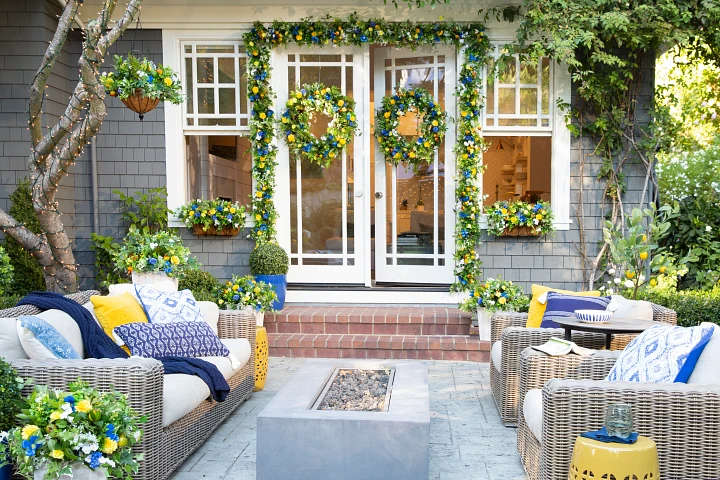Changing your decor between seasons is not only a fun creative process, but also a practical way to keep your living space fresh. As the seasons change, your home can reflect the colors, textures, and mood of the outside world. Rather than redecorating your entire home every few months, make small, intentional changes to keep your home looking stylish without taking up too much of your time or budget. The key is to create a flexible base decor that allows you to easily change styles, but still retains the essence of the season.
When spring returns to the earth, winter is over, and spring is here, people naturally crave freshness, brightness, and new life. Swapping breathable linen or cotton for heavier fabrics like wool or velvet can instantly change the mood. Throw pillows and blankets in pastel or floral patterns can replace deep, cozy hues. Lightweight, sheer curtains allow more sunlight into your space and create a welcoming atmosphere. Spring-themed accessories, like a vase of fresh tulips or daffodils, can bring the outdoors in. You can also remove heavy rugs and opt for lighter textures or bare floorboards to make your space feel more open and airy.
When summer comes, the transition of your space still focuses on brightness and simplicity. Minimalism works best in the warmer months. Consider removing unnecessary decorations and opting for a more open and uncluttered look. Beachy elements like driftwood, shells or nautical prints can create a relaxing atmosphere and make you feel like you’re in a seaside resort. Adding some bright colors like turquoise, coral or sunny yellow can create a vibrant and welcoming atmosphere in your space. Houseplants also thrive in the summer sun and are a great way to bring a bit of nature into your home. You can rearrange your furniture to make room for social gatherings or, if you have a patio or balcony, create a cozy corner outside.
As summer fades and fall approaches, the colors in homes change to warm and comfortable. Layering is in fashion. Add soft blankets, textured pillows, and rugs in rich colors like burnt orange, deep red, or golden yellow. You can update your table settings and mantelpieces with seasonal items like small pumpkins, leaves, or gourds. Wooden decorations and candlelight create a warm ambiance. As the day progresses, mood lighting like floor lamps and string lights can create a soft, welcoming atmosphere. Scented candles with fall scents like cinnamon, apple, or clove can enhance the mood of fall and make your space feel more inviting.
The arrival of winter calls for ultimate comfort and warmth. This season, the focus is on creating a sanctuary where you can escape the cold and relax. Swap out lightweight fabrics for heavier fabrics like faux fur, flannel, or velvet. Deep, moody hues like forest green, burgundy, and navy are great choices for the colder months. Decorative items like knitted blankets, layered rugs, and thick curtains not only add warmth but also create a more intimate feel. Holiday decorations can be subtle and sophisticated or playful and festive, depending on your personal style. Adding metallic accents like gold or silver, winter-themed branches, and winter-themed artwork will keep your space feeling cheerful and festive long after the holidays are over.
Using textiles is one of the easiest ways to transition between seasons. Pillows, blankets, curtains, and even bedding can be easily swapped out as the seasons change, allowing you to adapt to different temperatures and visual moods. Create a storage system that allows you to easily swap out items as the seasons change. This small change can have a big impact without the need for drastic changes.
Color also plays an important role in the transition of seasons. Consider choosing neutral tones for your furniture and walls so that you can change the colors of your interior throughout the year. This approach gives you flexibility and allows your space to change naturally with the seasons. For example, keep your sofa and rug in neutral tones and change out the pillows or artwork to create a fresh look.
Incorporating natural elements into your interior can modernize your home. Spring brings flowers and buds. In summer, you can add shells or tropical leaves. Fall is a good time to display pineapples, dried wheat cobs, or tree branches. In the An annual focal point that can be updated throughout the year. A mantelpiece, a console table in the hallway, or a shelf in the living room can all serve as a changing seasonal display. Keep a small amount of decorations in your home for each season and change them out as needed. This will keep your interior fresh and make the transition easier to manage.
Finally, seasonal decoration doesn’t have to be overly expensive or complicated. You don’t have to buy new items every season. By repurposing things you already have, shopping secondhand, and making small decorations yourself, you can make your spending more budget-friendly. The goal is to create a living environment that makes you feel in tune with the rhythm of the year and that promotes your comfort and well-being.
In short, the key to changing your interior style with the seasons is to make thoughtful changes that reflect the essence of each season of the year. By using flexible bases, changing textiles, adjusting the lighting, and integrating nature, your home will remain beautiful and functional without having to constantly adjust it. Seasonal decor can enrich your everyday experience, add warmth to your space, and help you celebrate the unique beauty each season has to offer.




